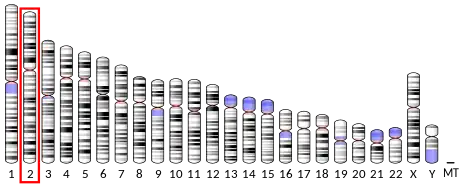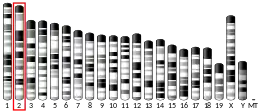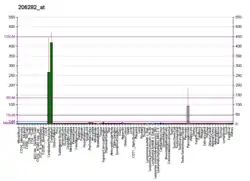NEUROD1
Neurogenic differentiation 1 (Neurod1), also called β2,[5] is a transcription factor of the NeuroD-type. It is encoded by the human gene NEUROD1.
In mice, Neurod1 expression is first seen at embryonic day 12 (E12).[6]
It is a member of the Neurod family of basic helix-loop-helix (bHLH) transcription factors, composed of Neurod1, Neurod2, Neurod4, and Neurod6. The protein forms heterodimers with other bHLH proteins and activates transcription of genes that contain a specific DNA sequence known as the E-box. It regulates expression of the insulin gene, and mutations in this gene result in type II diabetes mellitus in mouse models and in human clinical patients.[7]
Neurod1 is found to convert reactive glial cells into functional neurons in the mouse brain in vivo[8] In the adult cortex, Neurod1 expression is a marker of mature excitatory pyramidal neurons in the upper-most layers of the cortex.[9]
References
- GRCh38: Ensembl release 89: ENSG00000162992 - Ensembl, May 2017
- GRCm38: Ensembl release 89: ENSMUSG00000034701 - Ensembl, May 2017
- "Human PubMed Reference:". National Center for Biotechnology Information, U.S. National Library of Medicine.
- "Mouse PubMed Reference:". National Center for Biotechnology Information, U.S. National Library of Medicine.
- Poulin G, Turgeon B, Drouin J (November 1997). "NeuroD1/beta2 contributes to cell-specific transcription of the proopiomelanocortin gene". Molecular and Cellular Biology. 17 (11): 6673–82. doi:10.1128/mcb.17.11.6673. PMC 232521. PMID 9343431.
- Bormuth, Ingo; Yan, Kuo; Yonemasu, Tomoko; Gummert, Maike; Zhang, Mingyue; Wichert, Sven; Grishina, Olga; Pieper, Alexander; Zhang, Weiqi; Goebbels, Sandra; Tarabykin, Victor; Nave, Klaus-Armin; Schwab, Markus H. (2013-01-09). "Neuronal Basic Helix–Loop–Helix Proteins Neurod2/6 Regulate Cortical Commissure Formation before Midline Interactions". Journal of Neuroscience. 33 (2): 641–651. doi:10.1523/JNEUROSCI.0899-12.2013. ISSN 0270-6474. PMC 6704922. PMID 23303943. S2CID 25600245.
- Malecki, Maciej T.; Jhala, Ulupi S.; Antonellis, Anthony; Fields, Liz; Doria, Alessandro; Orban, Tihamer; Saad, Mohammed; Warram, James H.; Montminy, Marc; Krolewski, Andrzej S. (November 1999). "Mutations in NEUROD1 are associated with the development of type 2 diabetes mellitus". Nature Genetics. 23 (3): 323–328. doi:10.1038/15500. ISSN 1546-1718. PMID 10545951. S2CID 3216136.
- Guo Z, Zhang L, Wu Z, Chen Y, Wang F, Chen G (February 2014). "In vivo direct reprogramming of reactive glial cells into functional neurons after brain injury and in an Alzheimer's disease model". Cell Stem Cell. 14 (2): 188–202. doi:10.1016/j.stem.2013.12.001. PMC 3967760. PMID 24360883.
- Tutukova, Svetlana; Tarabykin, Victor; Hernandez-Miranda, Luis R. (2021). "The Role of Neurod Genes in Brain Development, Function, and Disease". Frontiers in Molecular Neuroscience. 14: 662774. doi:10.3389/fnmol.2021.662774. ISSN 1662-5099. PMC 8221396. PMID 34177462.
- Marcora E, Gowan K, Lee JE (August 2003). "Stimulation of NeuroD activity by huntingtin and huntingtin-associated proteins HAP1 and MLK2". Proceedings of the National Academy of Sciences of the United States of America. 100 (16): 9578–83. Bibcode:2003PNAS..100.9578M. doi:10.1073/pnas.1133382100. PMC 170960. PMID 12881483.
- Zhao L, Guo M, Matsuoka TA, Hagman DK, Parazzoli SD, Poitout V, Stein R (March 2005). "The islet beta cell-enriched MafA activator is a key regulator of insulin gene transcription". The Journal of Biological Chemistry. 280 (12): 11887–94. doi:10.1074/jbc.M409475200. PMID 15665000.
- Ratineau C, Petry MW, Mutoh H, Leiter AB (March 2002). "Cyclin D1 represses the basic helix-loop-helix transcription factor, BETA2/NeuroD". The Journal of Biological Chemistry. 277 (11): 8847–53. doi:10.1074/jbc.M110747200. PMID 11788592.
Further reading
- Fajans SS, Bell GI, Polonsky KS (September 2001). "Molecular mechanisms and clinical pathophysiology of maturity-onset diabetes of the young". The New England Journal of Medicine. 345 (13): 971–80. doi:10.1056/NEJMra002168. PMID 11575290.
- Cho JH, Tsai MJ (August 2004). "The role of BETA2/NeuroD1 in the development of the nervous system". Molecular Neurobiology. 30 (1): 35–47. doi:10.1385/MN:30:1:035. PMID 15247487. S2CID 19923393.
- Chae JH, Stein GH, Lee JE (December 2004). "NeuroD: the predicted and the surprising". Molecules and Cells. 18 (3): 271–88. PMID 15650322.
- Tamimi R, Steingrimsson E, Copeland NG, Dyer-Montgomery K, Lee JE, Hernandez R, Jenkins NA, Tapscott SJ (June 1996). "The NEUROD gene maps to human chromosome 2q32 and mouse chromosome 2". Genomics. 34 (3): 418–21. doi:10.1006/geno.1996.0306. PMID 8786144.
- Yokoyama M, Nishi Y, Miyamoto Y, Nakamura M, Akiyama K, Matsubara K, Okubo K (November 1996). "Molecular cloning of a human neuroD from a neuroblastoma cell line specifically expressed in the fetal brain and adult cerebellum". Brain Research. Molecular Brain Research. 42 (1): 135–9. doi:10.1016/S0169-328X(96)00154-4. PMID 8915591.
- Yokoyama M, Nishi Y, Yoshii J, Okubo K, Matsubara K (October 1996). "Identification and cloning of neuroblastoma-specific and nerve tissue-specific genes through compiled expression profiles". DNA Research. 3 (5): 311–20. doi:10.1093/dnares/3.5.311. PMID 9039501.
- Acharya HR, Dooley CM, Thoreson WB, Ahmad I (April 1997). "cDNA cloning and expression analysis of NeuroD mRNA in human retina". Biochemical and Biophysical Research Communications. 233 (2): 459–63. doi:10.1006/bbrc.1997.6483. PMID 9144558.
- Poulin G, Turgeon B, Drouin J (November 1997). "NeuroD1/beta2 contributes to cell-specific transcription of the proopiomelanocortin gene". Molecular and Cellular Biology. 17 (11): 6673–82. doi:10.1128/mcb.17.11.6673. PMC 232521. PMID 9343431.
- Furuta H, Horikawa Y, Iwasaki N, Hara M, Sussel L, Le Beau MM, Davis EM, Ogata M, Iwamoto Y, German MS, Bell GI (August 1998). "Beta-cell transcription factors and diabetes: mutations in the coding region of the BETA2/NeuroD1 (NEUROD1) and Nkx2.2 (NKX2B) genes are not associated with maturity-onset diabetes of the young in Japanese". Diabetes. 47 (8): 1356–8. doi:10.2337/diabetes.47.8.1356. PMID 9703340.
- Yoon YS, Noma T, Yamashiro Y, Ito H, Nakazawa A (July 1998). "Molecular cloning and characterization of the gene encoding human NeuroD". Neuroscience Letters. 251 (1): 17–20. doi:10.1016/S0304-3940(98)00490-X. PMID 9714454. S2CID 39872130.
- Miyachi T, Maruyama H, Kitamura T, Nakamura S, Kawakami H (June 1999). "Structure and regulation of the human NeuroD (BETA2/BHF1) gene". Brain Research. Molecular Brain Research. 69 (2): 223–31. doi:10.1016/S0169-328X(99)00112-6. PMID 10366743.
- Noma T, Yoon YS, Yamashiro Y, Fujisawa K, Nakazawa A (September 1999). "Regulation of NeuroD expression by activation of the protein kinase-C pathway in Y79 human retinoblastoma cells". Neuroscience Letters. 272 (1): 45–8. doi:10.1016/S0304-3940(99)00569-8. PMID 10507539. S2CID 3158332.
- Malecki MT, Jhala US, Antonellis A, Fields L, Doria A, Orban T, Saad M, Warram JH, Montminy M, Krolewski AS (November 1999). "Mutations in NEUROD1 are associated with the development of type 2 diabetes mellitus". Nature Genetics. 23 (3): 323–8. doi:10.1038/15500. PMID 10545951. S2CID 3216136.
- Glick E, Leshkowitz D, Walker MD (January 2000). "Transcription factor BETA2 acts cooperatively with E2A and PDX1 to activate the insulin gene promoter". The Journal of Biological Chemistry. 275 (3): 2199–204. doi:10.1074/jbc.275.3.2199. PMID 10636926.
- Onions J, Hermann S, Grundström T (April 2000). "A novel type of calmodulin interaction in the inhibition of basic helix-loop-helix transcription factors". Biochemistry. 39 (15): 4366–74. doi:10.1021/bi992533u. PMID 10757985.
- Mochizuki M, Amemiya S, Kobayashi K, Kobayashi K, Ishihara T, Aya M, Kato K, Kasuga A, Nakazawa S (January 2002). "The association of Ala45Thr polymorphism in NeuroD with child-onset Type 1a diabetes in Japanese". Diabetes Research and Clinical Practice. 55 (1): 11–7. doi:10.1016/S0168-8227(01)00242-X. PMID 11755474.
- Ratineau C, Petry MW, Mutoh H, Leiter AB (March 2002). "Cyclin D1 represses the basic helix-loop-helix transcription factor, BETA2/NeuroD". The Journal of Biological Chemistry. 277 (11): 8847–53. doi:10.1074/jbc.M110747200. PMID 11788592.
- Westerman BA, Poutsma A, Maruyama K, Schrijnemakers HF, van Wijk IJ, Oudejans CB (April 2002). "The proneural genes NEUROD1 and NEUROD2 are expressed during human trophoblast invasion". Mechanisms of Development. 113 (1): 85–90. doi:10.1016/S0925-4773(01)00665-7. PMID 11900979. S2CID 11607202.
- Kanatsuka A, Tokuyama Y, Nozaki O, Matsui K, Egashira T (September 2002). "Beta-cell dysfunction in late-onset diabetic subjects carrying homozygous mutation in transcription factors NeuroD1 and Pax4". Metabolism. 51 (9): 1161–5. doi:10.1053/meta.2002.34707. PMID 12200761.
External links
- NEUROD1+protein,+human at the U.S. National Library of Medicine Medical Subject Headings (MeSH)
This article incorporates text from the United States National Library of Medicine, which is in the public domain.




